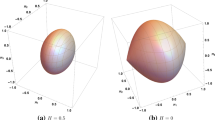Abstract
We propose the Ptolemaic transformation: a canonical change of variables reducing the Keplerian motion to the form of a perturbed Hamiltonian problem. As a solution of the unperturbed case, the Ptolemaic variables define an intermediary orbit, accurate up to the first power of eccentricity, like in the kinematic model of Claudius Ptolemy. In order to normalize the perturbed Hamiltonian we modify the recurrent Lie series algorithm of HoriuuMersman. The modified algorithm accounts for the loss of a term's order during the evaluation of a Poisson bracket, and thus can be also applied in resonance problems. The normalized Hamiltonian consists of a single Keplerian term; the mean Ptolemaic variables occur to be trivial, linear functions of the Delaunay actions and angles. The generator of the transformation may serve to expand various functions in Poisson series of eccentricity and mean anomaly.
Similar content being viewed by others
References
Breiter, S. and Métris, M.: 1994, 'Keplerian expansions in terms of Henrard's practical variables', Celest. Mech. & Dyn. Astr. 58, 237uu244.
Deprit, A.: 1969, 'Canonical transformations depending on a small parameter', Celest. Mech. 1, 12uu30.
Deprit, A. and Rom, A.: 1970, 'Characteristic exponents at L4 in the elliptic restricted problem', Astron. & Astrophys. 5, 416uu425.
Deprit, A., Henrard, J. and Rom, A.: 1971, 'Analytical lunar ephemeris. I. Definition of the main problem', Astron. & Astrophys. 10, 257uu269.
Ferraz-Mello, S.: 1997, 'On Hamiltonian averaging theories and resonance', Celest. Mech. & Dyn. Astr. 66, 39uu50.
Henrard, J.: 1970, 'Perturbation technique in the theory of nonlinear oscillations and in celestial mechanics', Boeing Scientific Research Laboratories, Mathematical and Information Sciences Report No 44.
Henrard, J.: 1974, 'Virtual singularities in the artificial satellite theory', Celest. Mech. 10, 437uu450.
Henrard, J.: 2000, 'A note on a general algorithm for two-body expansions', Celest. Mech. & Dyn. Astr. 76, 283uu289.
Hori, G.-I.: 1966, 'Theory of general perturbations with unspecified canonical variables', Publ. Astron. Soc. Jap. 18, 287uu296.
Idelson, N. I.: 1975, Etudes on the History of Celestial Mechanics (in Russian), Nauka, Moskva, pp. 141uu147.
Mersman, W. A.: 1970, 'A new algorithm for the Lie transformation', Celest. Mech. 3, 81uu89.
Oberti, P.: 1994, 'The main problem of geosynchronous satellite theory around an equilibrium position', Astron. & Astrophys. 284, 281uu284.
Author information
Authors and Affiliations
Rights and permissions
About this article
Cite this article
Breiter, S., Métris, G. Ptolemaic Transformation in Keplerian Problem. Celestial Mechanics and Dynamical Astronomy 84, 319–330 (2002). https://doi.org/10.1023/A:1021110830797
Issue Date:
DOI: https://doi.org/10.1023/A:1021110830797



